Consumer Acceptance and Market Potential of Iodine-Biofortified Fruit and Vegetables in Germany
Abstract
:1. Introduction
- What is the level of knowledge of the German population regarding the trace element iodine in terms of deficiency symptoms, and which food sources are preferred?
- Who are the potential consumer target groups of iodine-biofortified fruit and vegetables? What are their motives for buying these products?
- Do the target groups of iodine-biofortified fruit and vegetables differ from users of dietary supplements in their characteristics and motives?
- How should the market launch of iodine-biofortified fruit and vegetables be prepared conceptually? Which distribution channels in food retailing offer the greatest market potential for these functional fresh foods?
2. Materials and Methods
2.1. Data Collection
2.2. Study Design
2.3. Statistical Analysis
3. Results
3.1. Level of Knowledge of the German Population about the Mineral Micronutrient Iodine
3.2. Comparison of the Target Groups of Iodine-Biofortified Fruit and Vegetables versus Dietary Supplements
3.3. Market Potential for Iodine-Biofortified Fruit and Vegetables in Food Retailing
3.4. Labelling and Market Launch of Iodine-Biofortified Fruit and Vegetables
3.5. Consumer Perception of Different Methods to Biofortify Fruit and Vegetables with Iodine
3.6. Consumer Perception of Iodine-Biofortified Fruit and Vegetables Compared to Dietary Supplements
4. Discussion
4.1. Germans’ Consumer Knowledge about the Mineral Micronutrient Iodine
4.2. Target Groups of Iodine-Biofortified Fresh Produce versus Dietary Supplements
4.3. Market Potential for Iodine-Biofortified Fruit and Vegetabeles in Different Food-Trade Channels
4.4. Conceptual Market Launch of Iodine-Biofortified Foods
4.5. Limitations of the Present Study and Implications for Further Research
5. Conclusions
Author Contributions
Funding
Institutional Review Board Statement
Informed Consent Statement
Data Availability Statement
Conflicts of Interest
Appendix A
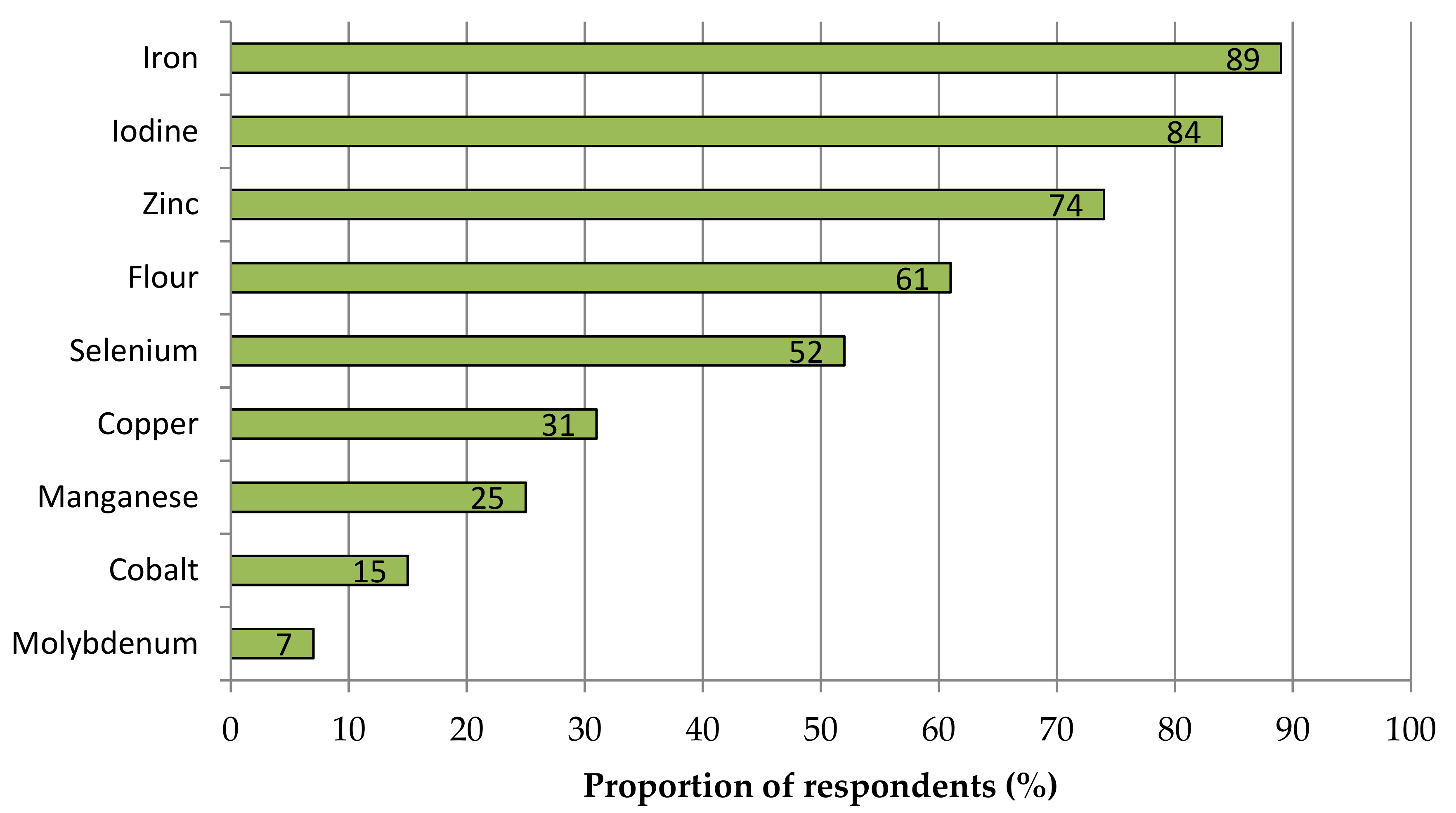
| Effect of Iodine | Number | % |
|---|---|---|
| Definitely positive | 172 | 16.9 |
| Rather positive | 514 | 50.6 |
| Undecided | 283 | 27.8 |
| Rather negative | 42 | 4.1 |
| Definitely negative | 5 | 0.5 |

| Product | Number of Persons | Number in Percent |
|---|---|---|
| Apple | 272 | 27 |
| Lettuce | 168 | 17 |
| Tomato | 66 | 6 |
| Basil | 49 | 5 |
| Product | Customers of Farmers’ Markets, Organic Produce Shops, and Farm Stores | Discount Consumers | Supermarket Consumers |
|---|---|---|---|
| With information text | |||
| Apple | 42.9% | 32.4% | 30.9% |
| Tomato | 42.9% | 38.1% | 39.8% |
| Lettuce | 42.9% | 28.4% | 31.7% |
| Basil | 26.8% | 19.3% | 20.8% |
| Without information text | |||
| Apple | 40.8% | 32.9% | 28.6% |
| Tomato | 40.8% | 35.5% | 29.6% |
| Lettuce | 42.9% | 27.1% | 24.7% |
| Basil | 28.6% | 18.7% | 18.8% |
| Product | Customers of Farmers’ Markets, Organic Produce Shops, and Farm Stores | Discount Consumers | Supermarket Consumers |
|---|---|---|---|
| Clearly negative impact | - | 0.6% | 0.5% |
| Rather negative impact | 2.9% | 3.6% | 4.9% |
| Undecided | 23.8% | 28.7% | 27.7% |
| Rather positive impact | 48.6% | 51.7% | 50.7% |
| Clearly positive impact | 24.8% | 15.4% | 16.1% |
| Product | With Information Text (Mean Value) | Without Information Text (Mean Value) | Test of Difference 1 |
|---|---|---|---|
| Apple | 0.294 | 0.180 | F(1.270) = 1.632, p = 0.203 |
| Lettuce | 0.006 | 0.157 | F(1.273) = 0.037 p = 0.847 |
| Tomato | 0.050 | 0.214 | F(1.370) = 0.232 p = 0.630 |
| Basil | 0.002 | 0.200 | F(1.095) = 0.009 p = 0.925 |
Appendix B
| Food survey Processing time: approx. 20 min. |
| Welcome! Osnabrück University of Applied Sciences is conducting a consumer survey on the topic of food and nutrition as part of a research project. Please support us with your personal experiences and ideas. The survey will take about 20 min. Take part! |
| Daily | Several times a week | About weekly | Several times per month | About monthly | More rarely | Never | |
| Local fruit (e.g., apples, strawberries) | 1 □ | 2 □ | 3 □ | 4 □ | 5 □ | 6 □ | 0 □ |
| Fruiting vegetables (e.g., tomatoes, cucumbers) | 1 □ | 2 □ | 3 □ | 4 □ | 5 □ | 6 □ | 0 □ |
| Leafy vegetables (e.g., lettuce, lamb’s lettuce) | 1 □ | 2 □ | 3 □ | 4 □ | 5 □ | 6 □ | 0 □ |
| Potted herbs (e.g., basil, parsley) | 1 □ | 2 □ | 3 □ | 4 □ | 5 □ | 6 □ | 0 □ |
| 1 □ | Male |
| 2 □ | Female |
| 1 □ | Baden-Württemberg |
| 2 □ | Bavaria |
| 3 □ | Berlin |
| 4 □ | Brandenburg |
| 5 □ | Bremen |
| 6 □ | Hamburg |
| 7 □ | Hesse |
| 8 □ | Mecklenburg-Western Pomerania |
| 9 □ | Lower Saxony |
| 10 □ | North Rhine-Westphalia |
| 11 □ | Rhineland-Palatinate |
| 12 □ | Saarland |
| 13 □ | Saxony |
| 14 □ | Saxony-Anhalt |
| 15 □ | Schleswig-Holstein |
| 16 □ | Thuringia |
| 2 □ | Mainly myself |
| 1 □ | Myself and another person |
| 0 □ | Almost always another person → screenout |
| Main survey: The following questions are about your fresh fruit and vegetable buying habits. | |
| 1 □ | Discounters (e.g., Aldi) | |
| 2 □ | Supermarket (e.g., EDEKA, REWE) | |
| 3 □ | Department stores (e.g., Galeria Kaufhof) | |
| 4 □ | Weekly market | |
| 5 □ | Organic shop | |
| 6 □ | Farm shop | |
| 7 □ | I am self-sufficient (e.g., own garden) | |
| 8 □ | Other, namely | |
| □ | ...produced without the use of pesticides. |
| □ | ...free from additives. |
| □ | ...raw or uncooked. |
| □ | ...fresh products. |
| □ | ...produced without genetic modification. |
| □ | ...unadulterated in taste. |
| □ | ...produced without the use of fertilizers. |
| □ | Other, namely: |
| Information on ingredients and trace elements in foods | |
| □ | Fluorine |
| □ | Cobalt |
| □ | Molybdenum |
| □ | Manganese |
| □ | Copper |
| □ | Zinc |
| □ | Iron |
| □ | Iodine |
| □ | Selenium |
| 0 □ | None of the above |
| 4 □ | Yes, I always pay attention to them |
| 3 □ | Yes, I often pay attention to them |
| 2 □ | Yes, but I rarely pay attention to them |
| 1 □ | No, I do not pay attention to them |
| 0 □ | I have never seen such a label before |
| Clearly positive effect | Rather positive Effect | Undecided | Rather negative Effect | Clearly negative effect |
| +2 □ | +1 □ | 0 □ | −1 □ | −2 □ |
| □ | Goiter (swelling of the front of the neck) |
| □ | Thyroid dysfunctions, and diseases |
| □ | Disorders in hormone metabolism |
| □ | Fatigue, lack of drive, and depressed mood |
| □ | Learning and memory difficulties |
| □ | Dry skin, and brittle hair |
| □ | Increased risk of miscarriage |
| □ | Impaired brain maturation during pregnancy |
| □ | Attention deficit hyperactivity disorder (ADHD) in children |
| □ | Intelligence impairment in children |
| 0 □ | Don’t know |
| 3 □ | Yes, several persons |
| 2 □ | Yes, one person |
| 1 □ | I have never dealt with the subject before |
| 0 □ | Don’t know |
| Very big contribution | Medium contribution | Minor contribution | No contribution at all | |
| Fish and seafood | 1 □ | 2 □ | 3 □ | 4 □ |
| Fruit | 1 □ | 2 □ | 3 □ | 4 □ |
| Vegetables | 1 □ | 2 □ | 3 □ | 4 □ |
| Bread, and cereal products | 1 □ | 2 □ | 3 □ | 4 □ |
| Milk, and dairy products | 1 □ | 2 □ | 3 □ | 4 □ |
| Meat, and meat products | 1 □ | 2 □ | 3 □ | 4 □ |
| Drinking water, and non-alcoholic drinks | 1 □ | 2 □ | 3 □ | 4 □ |
| Confectionery, and nibbles | 1 □ | 2 □ | 3 □ | 4 □ |
| □ | Fish |
| □ | Iodized table salt |
| □ | Food supplements |
| □ | Food made with iodized table salt and labelled accordingly. |
| □ | Other foods rich in iodine, namely: _________________________ |
| 0 □ | I do not worry about this |
| □ | Meat, and meat products |
| □ | Milk, and dairy products |
| □ | Cereals, and cereal products |
| □ | Fresh vegetables |
| □ | Processed vegetable products |
| □ | Fresh fruit |
| □ | Processed fruit products |
| □ | Confectionery, and nibbles |
| □ | Non-alcoholic drinks |
| □ | Alcoholic beverages |
| □ | Eggs, and egg products |
| □ | With no food |
| Concept test: introduction of new iodine products |
| Is of great use for my health | Rather useful | Partly/partly | Not really useful | Is of no use for my health | |
| Contributes to normal cognitive function, such as perceiving, memorizing, and learning. | +2 □ | +1 □ | 0 □ | −1 □ | −2 □ |
| Contributes to a normal energy metabolism. | +2 □ | +1 □ | 0 □ | −1 □ | −2 □ |
| Contributes to the normal functioning of the nervous system. | +2 □ | +1 □ | 0 □ | −1 □ | −2 □ |
| Contributes to the maintenance of normal skin. | +2 □ | +1□ | 0 □ | −1 □ | −2 □ |
| Contributes to the normal production of thyroid hormones. | +2 □ | +1 □ | 0 □ | −1 □ | −2 □ |
| Contributes to normal thyroid function | +2 □ | +1 □ | 0 □ | −1 □ | −2 □ |
 |
| A current study by the Robert Koch Institute shows that a relatively large number of people in Germany still consume too little iodine with their food. Even a mild iodine deficiency can have very negative effects (e.g., thyroid disorders, learning and attention problems in children). It is therefore important to further improve the iodine supply. Iodine-rich fruit and vegetables can make a contribution to this. |
| Randomize | Appeals to me a lot | Tends to appeal to me | Partly/ Partly | Tends not to appeal to me | Does not appeal to me at all |
Apple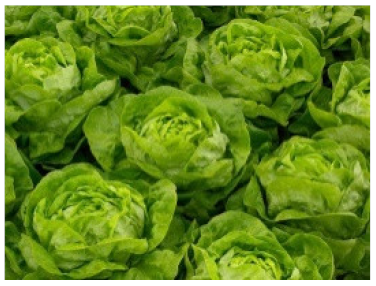 | +2 □ | +1 □ | 0 □ | −1 □ | −2 □ |
Lettuce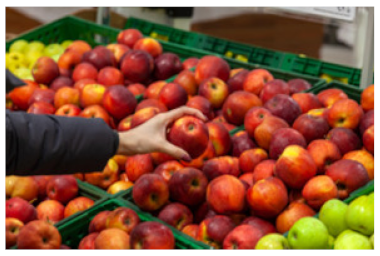 | +2 □ | +1 □ | 0 □ | −1 □ | −2 □ |
Tomatoes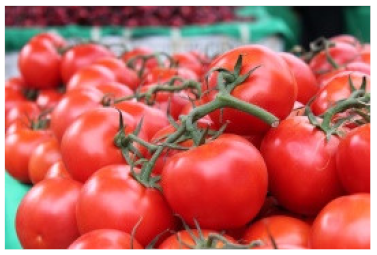 | +2 □ | +1 □ | 0 □ | −1 □ | −2 □ |
Basil | +2 □ | +1 □ | 0 □ | −1 □ | −2 □ |
| Randomize | Appeals to me a lot | Tends to appeal to me | Partly/ Partly | Tends not to appeal to me | Does not appeal to me at all |
Apple | +2 □ | +1 □ | 0 □ | −1 □ | −2 □ |
Lettuce | +2 □ | +1 □ | 0 □ | −1 □ | −2 □ |
Tomatoes | +2 □ | +1 □ | 0 □ | −1 □ | −2 □ |
Basil | +2 □ | +1 □ | 0 □ | −1 □ | −2 □ |
| 3 □ | Apples |
| 2 □ | Lettuce |
| 1 □ | Tomatoes |
| 0 □ | Basil |
 |  |  |  | ||
| Apples | Lettuce | Tomatoes | Basil | ||
| 8□ | € 2.49 | € 0.79 | € 2.49 | € 1.19 | |
| 7□ | € 2.69 | € 0.89 | € 2.69 | € 1.29 | |
| 6□ | € 2.99 | € 0.99 | € 2.99 | € 1.49 | |
| 5□ | € 3.29 | € 1.09 | € 3.29 | € 1.69 | |
| 4□ | € 3.49 | € 1.29 | € 3.49 | € 1.99 | |
| 3□ | € 3.99 | € 1.49 | € 3.99 | € 2.29 | |
| 2□ | € 4.99 | € 1.69 | € 4.99 | € 2.49 | |
| 1□ | € 5.99 | € 1.89 | € 5.99 | € 2.89 | |
| 0 □ | I am not willing to pay more than the current available price (internal info: Corresponds to Code 8; Built in as an option for people who do not want to deal with an additional price within the framework of this concept) | ||||
| 1 | 2 | 3 | 4 | 5 |
| 1 □ | 2 □ | 3 □ | 4 □ | 5 □ |
| Appeals to me a lot | Tends to appeal to me | Partly/ Partly | Tends not to appeal to me | Does not appeal to me at all | |
| High iodine content | +2 □ | +1 □ | 0 □ | −1 □ | −2 □ |
| Iodine source | +2 □ | +1 □ | 0 □ | −1 □ | −2 □ |
| Enriched with iodine | +2 □ | +1 □ | 0 □ | −1 □ | −2 □ |
| Biofortified with iodine | +2 □ | +1 □ | 0 □ | −1 □ | −2 □ |
| Rich in iodine | +2 □ | +1 □ | 0 □ | −1 □ | −2 □ |
| Appeals to me a lot | Tends to appeal to me | Partly/ Partly | Tends not to appeal to me | Does not appeal to me at all | |
| Possible reasons to buy fresh fruit and vegetables | |||||
| From integrated cultivation | +2 □ | +1 □ | 0 □ | −1 □ | −2 □ |
| From my region | +2 □ | +1 □ | 0 □ | −1 □ | −2 □ |
| From German origin | +2 □ | +1 □ | 0 □ | −1 □ | −2 □ |
| Particularly suitable for a vegetarian and vegan diet | +2 □ | +1 □ | 0 □ | −1 □ | −2 □ |
| Particularly suitable for a low-allergen diet | +2 □ | +1 □ | 0 □ | −1 □ | −2 □ |
| From organic cultivation | +2 □ | +1 □ | 0 □ | −1 □ | −2 □ |
| Possible reasons to buy packaging | |||||
| Unpacked | +2 □ | +1 □ | 0 □ | −1 □ | −2 □ |
| No plastic content in the packaging | +2 □ | +1 □ | 0 □ | −1 □ | −2 □ |
| Strongly agree | Tends to apply | Partly/ Partly | Tends not to apply | Strongly disagree | |
| Iodine fertilization of the soil | |||||
| Healthy | +2 □ | +1 □ | 0 □ | −1 □ | −2 □ |
| Trustworthy | +2 □ | +1 □ | 0 □ | −1 □ | −2 □ |
| Effective | +2 □ | +1 □ | 0 □ | −1 □ | −2 □ |
| Natural | +2 □ | +1 □ | 0 □ | −1 □ | −2 □ |
| Environmentally friendly | +2 □ | +1 □ | 0 □ | −1 □ | −2 □ |
| Expensive | +2 □ | +1 □ | 0 □ | −1 □ | −2 □ |
| Iodine-containing feed additives in livestock farming | |||||
| Healthy | +2 □ | +1 □ | 0 □ | −1 □ | −2 □ |
| Trustworthy | +2 □ | +1 □ | 0 □ | −1 □ | −2 □ |
| Effective | +2 □ | +1 □ | 0 □ | −1 □ | −2 □ |
| Natural | +2 □ | +1 □ | 0 □ | −1 □ | −2 □ |
| Environmentally friendly | +2 □ | +1 □ | 0 □ | −1 □ | −2 □ |
| Expensive | +2 □ | +1 □ | 0 □ | −1 □ | −2 □ |
| Foliar fertilization of plants with iodine | |||||
| Healthy | +2 □ | +1 □ | 0 □ | −1 □ | −2 □ |
| Trustworthy | +2 □ | +1 □ | 0 □ | −1 □ | −2 □ |
| Effective | +2 □ | +1 □ | 0 □ | −1 □ | −2 □ |
| Natural | +2 □ | +1 □ | 0 □ | −1 □ | −2 □ |
| Environmentally friendly | +2 □ | +1 □ | 0 □ | −1 □ | −2 □ |
| Expensive | +2 □ | +1 □ | 0 □ | −1 □ | −2 □ |
| Iodine intake in food processing | |||||
| Healthy | +2 □ | +1 □ | 0 □ | −1 □ | −2 □ |
| Trustworthy | +2 □ | +1 □ | 0 □ | −1 □ | −2 □ |
| Effective | +2 □ | +1 □ | 0 □ | −1 □ | −2 □ |
| Natural | +2 □ | +1 □ | 0 □ | −1 □ | −2 □ |
| Environmentally friendly | +2 □ | +1 □ | 0 □ | −1 □ | −2 □ |
| Expensive | +2 □ | +1 □ | 0 □ | −1 □ | −2 □ |
| Breeding of iodine-rich plant varieties | |||||
| Healthy | +2 □ | +1 □ | 0 □ | −1 □ | −2 □ |
| Trustworthy | +2 □ | +1 □ | 0 □ | −1 □ | −2 □ |
| Effective | +2 □ | +1 □ | 0 □ | −1 □ | −2 □ |
| Natural | +2 □ | +1 □ | 0 □ | −1 □ | −2 □ |
| Environmentally friendly | +2 □ | +1 □ | 0 □ | −1 □ | −2 □ |
| Expensive | +2 □ | +1 □ | 0 □ | −1 □ | −2 □ |
| Health aspects of food consumption | |||||
| Agree completely | Tend to agree | Partly/partly | Tend not to agree | Strongly disagree | |
| I worry about hazardous chemicals in my food. | +2 □ | +1 □ | 0 □ | −1 □ | −2 □ |
| I am concerned about the quality of my drinking water. | +2 □ | +1 □ | 0 □ | −1 □ | −2 □ |
| I pay attention to the ingredients on the food labels when I shop. | +2 □ | +1 □ | 0 □ | −1 □ | −2 □ |
| The influence of diet on health is often overestimated. | +2 □ | +1□ | 0 □ | −1 □ | −2 □ |
| I never buy products for their health-promoting effect. | +2 □ | +1 □ | 0 □ | −1 □ | −2 □ |
| I often buy ready-made meals (e.g., pizza, canned meals). | +2 □ | +1 □ | 0 □ | −1 □ | −2 □ |
| 7□ | Every day |
| 6□ | Several times a week |
| 5□ | Once a week |
| 4□ | Several times a month |
| 3 □ | Once per month |
| 2□ | Once every 3 months |
| 1□ | Rarely |
| 0□ | I never/I do not take any food supplements |
| Rather rich in iodine (EDP: product + image from F20 fade in) | More like a dietary supplement with iodine | |
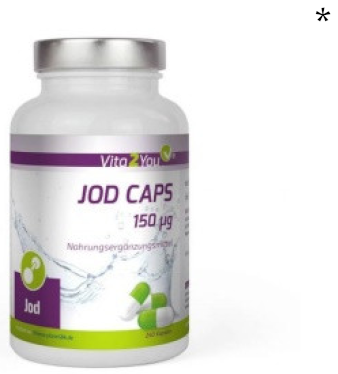 | ||
| Healthy | +1 □ | −1 □ |
| Trustworthy | +1 □ | −1 □ |
| Effective | +1 □ | −1 □ |
| Natural | +1 □ | −1 □ |
| Environmentally friendly | +1 □ | −1 □ |
| Expensive | +1 □ | −1 □ |
| Dosability | +1 □ | −1 □ |
| In the overall comparison, I prefer | +1 □ | −1 □ |
| 1 □ Yes |
| 0 □ No |
| 1 □ Yes |
| 0 □ No |
| 6 □ | I try to consciously eat less meat (e.g., flexitarians) |
| 5 □ | Vegan diet |
| 4 □ | Vegetarian diet (with milk and egg products) |
| 3 □ | Vegetarian diet (without milk and egg products) |
| 2 □ | Raw food diet |
| 1 □ | No special diet |
| 7 □ | I follow a different form of nutrition, namely: ____________________________________ |
| Sociodemographic criteria | |
| 1 □ Still a student |
| 2 □ Elementary/secondary school leaving certificate |
| 3 □ Middle school leaving certificate/secondary school leaving certificate |
| 4 □ “Abitur“ or equivalent |
| 5 □ Master craftsman/technician/technical college degree |
| 6 □ University of Applied Sciences/university degree |
| 0 □ Without a degree |
| 7□ Other, namely |
| 1 □ School pupil |
| 2 □ Trainee/Apprentice |
| 3 □ University student |
| 4 □ In full-time employment |
| 5 □ In part-time employment |
| 6 □ Pensioner |
| 7 □ Housewife/househusband |
| 8 □ Unemployed |
| 0 □ Not specified |
| 1 □ 1 person |
| 2 □ 2 persons |
| 3 □ 3 persons |
| 4 □ 4 persons |
| 5 □ 5 persons |
| 6 □ More than 5 persons |
| 0 □ Not specified |
References
- European Commission. Commission Regulation (EU) No. 432/2012. Off. J. Eur. Union 2012, 136, 1–40. [Google Scholar]
- Pretell, E.A.; Regional Co-ordinator South Asia Iodine Global Network; Pandav, C. Severe Iodine Deficiency. In Iodine Deficiency Disorders and Their Elimination; Springer: Singapore, 2017; pp. 45–57. [Google Scholar]
- European Food Safety Authority (EFSA). Scientific Option on Dietary Reference Values for iodine. EFSA J. 2014, 12, 2–4. [Google Scholar]
- Andersson, M.; Karumbunathan, V.; Zimmermann, M.B. Global Iodine Status in 2011 and Trends over the Past Decade. J. Nutr. 2012, 142, 744–750. [Google Scholar] [CrossRef] [PubMed]
- Zimmermann, M.B. Iodine. In Nutrition and Health in a Developing World, 3rd ed.; De Pee, S., Taren, D., Bloeam, M.W., Eds.; Springer Science + Business Media: New York, NY, USA, 2017; pp. 287–295. [Google Scholar]
- Johner, S.A.; Thamm, M.; Schmitz, R.; Remer, T. Examination of iodine status in the German population: An example for methodological pitfalls of the current approach of iodine status assessment. Eur. J. Nutr. 2016, 55, 1275–1282. [Google Scholar] [CrossRef] [PubMed]
- Gärtner, R. Recent data on iodine intake in Germany and Europe. J. Trace Elements Med. Biol. 2016, 37, 85–89. [Google Scholar] [CrossRef] [PubMed]
- Hey, I.; Thamm, M. Abschlussbericht: Monitoring der Jod-und Natriumversorgung bei Kindern und Jugendlichen im Rahmen der Studie des Robert Koch-Instituts zur Gesundheit von Kindern und Jugendlichen in Deutschland (KiGGS Welle 2). 2019. Available online: https://service.ble.de/ptdb/index2.php?detail_id=47144&site_key=145&zeilenzahl_zaehler=592&NextRow=330&pId=47144&dId=26027500 (accessed on 20 November 2021).
- Iodine Global Network. Global Scorecard of Iodine Nutrition in 2020 in the General Population Based on Schoolage Children (SAC); IGN: Ottawa, ON, Canada, 2020. [Google Scholar]
- IRI Information Resources, Inc. Absatz in Tonnen im deutschen Lebensmitteleinzelhandel: Salz ohne Gewürze mit dem Zusatz Jod, Jod+Flourid sowie Jod + Flourid + Folsäure 2015–2020. Personal communication with Südwestdeutsche Salzwerke AG, 2020; IRI Information Resources, Inc.: Chicago, IL, USA, 2020. [Google Scholar]
- Bissinger, K.; Herrmann, R.; Jordan, I. Salt iodisation of processed foods in Germany: Evidence, processors´perceptions and implications for public health. Br. Food J. 2021. ahead-of-print. [Google Scholar] [CrossRef]
- Kirchhoff, V.K.; Herrmann, R. Verbrauchereinstellung zum Salz- und Jodsalzkonsum in Lebensmitteln: Eine Befragungsstudie. Zeitschrift. für Agrarpolitik und Landwirtschaft 2020, 98, 1–31. [Google Scholar]
- Fessler, B. Deutschland—Ein Jodmangelland. Pädiatrie 2019, 31, 62. [Google Scholar] [CrossRef]
- Esche, J.; Thamm, M.; Remer, T. Contribution of iodized salt to total iodine and total salt intake in Germany. Eur. J. Nutr. 2020, 59, 3163–3169. [Google Scholar] [CrossRef]
- Strohm, D.; Boeing, H.; Leschik-Bonnet, E.; Heseker, H.; Arens-Azevêdo, U.; Bechthold, A.; Knorpp, L.; Kroke, A. Salt intake in Germany, health consequences, and resulting recommendations for action: A scientific statement from the German Nutrition Society (DGE). Ernährungs Umsch. 2016, 63, 62–70. [Google Scholar]
- Strohm, D.; Bechthold, A.; Ellinger, S.; Leschik-Bonnet, E.; Stehle, P.; Heseker, H.; Dge, G.N.S. Revised Reference Values for the Intake of Sodium and Chloride. Ann. Nutr. Metab. 2017, 72, 12–17. [Google Scholar] [CrossRef] [Green Version]
- Eveleigh, E.R.; Coneyworth, L.J.; Avery, A.; Welham, S.J.M. Vegans, Vegetarians, and Omnivores: How Does Dietary Choice Influence Iodine Intake? A Systematic Review. Nutrients 2020, 12, 1606. [Google Scholar] [CrossRef]
- AWA. Anzahl der Personen in Deutschland, die sich selbst als Vegetarier einordnen oder als Leute, die weitgehend auf Fleisch verzichten*, von 2007 bis 2021: Allensbacher Markt- und Werbeträger-Analyse. 2020. Available online: https://de.statista.com/statistik/daten/studie/173636/umfrage/lebenseinstellung-anzahl-vegetarier/ (accessed on 1 June 2021).
- Fuge, R. Soils and Iodine Deficiency. In Essentials of Medical Geology; Selinus, O., Alloway, B.J., Eds.; Springer Science + Business Media: Dordrecht, The Netherlands, 2013; pp. 417–432. [Google Scholar]
- Milagres, R.C.R.D.M.; De Souza, E.C.G.; Peluzio, M.D.C.G.; Franceschini, S.D.C.C.; Duarte, M.S.L. Food Iodine Content Table compiled from international databases. Revista de Nutrição 2020, 33, e190222. [Google Scholar] [CrossRef]
- Gonzali, S.; Kiferle, C.; Perata, P. Iodine biofortification of crops: Agronomic biofortification, metabolic engineering and iodine bioavailability. Curr. Opin. Biotechnol. 2017, 44, 16–26. [Google Scholar] [CrossRef] [Green Version]
- Wakeel, A.; Farooq, M.; Bashir, K.; Ozturk, L. Micronutrient Malnutrition and Biofortification: Recent Advances and Future Perspectives. In Plant Micronutrient Use Efficiency; Hossain, M.A., Kamiya, T., Burritt, D., Tran, L.P., Fujiwara, T., Eds.; Academic Press: Cambridge, MA, USA, 2018; pp. 225–243. [Google Scholar]
- Dávila-Rangel, I.E.; Leija-Martínez, P.; Medrano-Macías, J.; Fuentes-Lara, L.O.; González-Morales, S.; Juárez-Maldonado, A.; Benavides-Mendoza, A. Iodine Biofortification of Crops. In Nutritional Quality Improvement in Plants; Springer: Cham, Switzerland, 2019; pp. 79–113. [Google Scholar]
- Kiferle, C.; Gonzali, S.; Holwerda, H.T.; Ibaceta, R.R.; Perata, P. Tomato fruits: A good target for iodine biofortification. Front. Plant Sci. 2013, 4, 205. [Google Scholar] [CrossRef] [Green Version]
- Puccinelli, M.; Landi, M.; Maggini, R.; Pardossi, A.; Incrocci, L. Iodine biofortification of sweet basil and lettuce grown in two hydroponic systems. Sci. Hortic. 2021, 276, 109783. [Google Scholar] [CrossRef]
- Budke, C.; Dierend, W.; Schön, H.-G.; Hora, K.; Mühling, K.H.; Daum, D. Iodine Biofortification of Apples and Pears in an Orchard Using Foliar Sprays of Different Composition. Front. Plant Sci. 2021, 12, 638671. [Google Scholar] [CrossRef]
- Buturi, C.V.; Mauro, R.P.; Fogliano, V.; Leonardi, C.; Giuffrida, F. Mineral Biofortification of Vegetables as a Tool to Improve Human Diet. Foods 2021, 10, 223. [Google Scholar] [CrossRef]
- Bundesministerium für Enrähung und Landwirtschaft (BMEL). Deutschland, wie es isst. Der BMEL Ernährungs Rep. 2019, 9, 16–23. [Google Scholar]
- Wortmann, L.; Enneking, U.; Daum, D. German Consumers’ Attitude towards Selenium-Biofortified Apples and Acceptance of Related Nutriton and Health Claims. Nutrients 2018, 10, 190. [Google Scholar] [CrossRef] [Green Version]
- Timpanaro, G.; Bellia, C.; Forti, V.T.; Scuderi, A. Consumer Behaviour of Purchasing Biofortified Food Products. Sustainability 2020, 12, 6297. [Google Scholar] [CrossRef]
- European Union. Regulation (EC) No. 1924/2006 of the European Parliament and the Council of 20 December 2006 on nutrition and health claims made on foods. Off. J. Eur. Union 2006, 50, 16–17. [Google Scholar]
- European Commission. Functional Foods. 2010. Available online: http://www.eurosfaire.prd.fr/7pc/documents/1276590504_functional_foods_en_publi_ce.pdf (accessed on 20 November 2021).
- De Jong, N.; Ocké, M.C.; Branderhorst, H.A.C.; Friele, R. Demographic and lifestyle characteristics of functional food consumers and dietary supplement users. Br. J. Nutr. 2003, 89, 273–281. [Google Scholar] [CrossRef] [PubMed] [Green Version]
- Kunst, A. Umfrage zum Verzehr von speziellen Lebensmitteln in Deutschland 2017. Statista. Available online: https://de.statista.com/statistik/daten/studie/73600/umfrage/lebensmittel-mit-ergaenzungsstoffen-verzehr-haeufigkeit/ (accessed on 17 November 2020).
- Maier, S. Analyse der Verbrauchereinstellung von Best Agern bezüglich Functional Food. In Functional Food für Best Ager. Verbrauchereinstellungen und Empfehlungen eines zielgruppengerechten Marketing-Mix; Diplomica Verlag GmbH: Hamburg, Germany, 2011; Volume 15, pp. 49–74. [Google Scholar]
- Gesellschaft für integrierte Kommunikationsforschung. Verwender von Functional Food in Deutschland, Personal communication,2020. Available online: https://gik.media/best-4-planning/ (accessed on 20 November 2021).
- Viell, B. Funktionelle Lebensmittel und Nahrungsergänzungsmittel Wissenschaftliche Gesichtspunkte. Bundesgesundheitsblatt Gesundh. Gesundh. 2001, 3, 193–204. [Google Scholar] [CrossRef]
- Mansour, H. Germany Vitamins, Minerals and Supplements Market Report 2020; Mintel Group Ltd.: London, UK, 2021. [Google Scholar]
- Willers, J.; Heinemann, M.; Bitterlich, N.; Hahn, A. Intake of Minerals from Food Supplements in a German Population—A Nationwide Survey. Food Nutr. Sci. 2015, 6, 205–215. [Google Scholar] [CrossRef] [Green Version]
- Schwab, S.; Heier, M.; Schneider, A.; Fischer, B.; Huth, C.; Peters, A.; Thorand, B. The use of dietary supplements among older persons in Southern Germany—Results from the KORA-age study. J. Nutr. Heal. Aging 2013, 18, 510–519. [Google Scholar] [CrossRef]
- Reinert, A.; Rohrmann, S.; Becker, N.; Linseisen, J. Lifestyle and diet in people using dietary supplements. Eur. J. Nutr. 2007, 46, 165–173. [Google Scholar] [CrossRef]
- Heinemann, M.; Willers, J.; Bitterlich, N.; Hahn, A. Verwendung von Nahrungsergänzungsmitteln mit Vitaminen und Mineralstoffen—Ergebnisse einer deutschlandweiten Verbraucherbefragung. J. Consum. Prot. Food Saf. 2015, 10, 131–142. [Google Scholar] [CrossRef]
- Schweiger, F.; Haas, R. Nahrungsergänzungsmittel- Konsumentinnen/Konsumenten und deren Beweggründe zum Verzehr. In Die Nahrung der Optimisten. Eine Motivstudie zu Superfood und Nahrungsergänzungsmitteln; Springer Fachmedien Wiesbaden GmbH: Wiesbaden, Germany, 2020; pp. 47–50. [Google Scholar]
- Carrington, M.J.; Neville, B.A.; Whitwell, G.J. Why ethical consumers don’t walk their talk: Towards a framework for understianding the gap between the ethical purchase intentions and actual buying behaviour of ethically minded consumers. J. Bus. Ethics 2010, 97, 139–158. [Google Scholar] [CrossRef]
- Yeatman, H.; Charlton, K.E.; Houweling, F. Poor iodine status and knowledge related to iodine on the eve of mandatory iodine fortification in Australia. Asia Pac. J. Clin. Nutr. 2010, 19, 250–255. [Google Scholar]
- Henjum, S.; Brantsaeter, A.L.; Kurniasari, A.; Dahl, L.; Aadland, E.K.; Gjengedal, E.L.F.; Birkeland, S.; Aakre, I. Suboptimal Iodine Status and Low Iodine Knowledge in Young Norwegian Woman. Nutrients 2018, 10, 941. [Google Scholar] [CrossRef] [Green Version]
- Jooste, P.; Upson, N.; Charlton, K.E. Knowledge of iodine nutrition in the South African adult population. Public Health Nutr. 2005, 8, 382–386. [Google Scholar] [CrossRef]
- Kim, B.K.; Jeong, J.-Y.; Seok, K.-H.; Lee, A.S.; Oak, C.H.; Kim, G.C.; Jeong, C.-K.; Choi, S.I.; Afidchao, P.M.; Choi, Y.S. Current Iodine Nutrition Status and Awareness of Iodine Deficiency in Tuguegarao, Philippines. Int. J. Endocrinol. 2014, 2014, 1–7. [Google Scholar] [CrossRef]
- Adekunle, C.; Omosanya, R.; Shokunbi, S.; Ganiyu, S.; Popoola, A. Consumers’ acceptability of iodine-biofortified tomato in Abeokuta, Southwestern Nigeria. Niger. J. Biotechnol. 2019, 36, 130–137. [Google Scholar] [CrossRef]
- Großklaus, R.; Jahreis, G. Universelle Salzjodierung für Mensch und Tier. Ernährungs Umsch. Forsch. Prax. 2004, 51, 138–143. [Google Scholar]
- O’Kane, S.M.; Pourshahidi, L.K.; Farren, K.M.; Mulhern, M.S.; Strain, J.J.; Yeates, A.J. Iodine knowledge is positively associated with dietary iodine intake among women of childbearing age in the UK and Ireland. Br. J. Nutr. 2016, 116, 1728–1735. [Google Scholar] [CrossRef] [Green Version]
- Szakos, D.; Ózsvári, L.; Kasza, G. Perception of Older Adults about Health-Related Functionality of Foods Compared with Other Age Groups. Sustainability 2020, 12, 2748. [Google Scholar] [CrossRef] [Green Version]
- Van Kleef, E.; Van Trijp, H.C.; Luning, P. Functional foods: Health claim-food product compatibility and the impact of health claim framing on consumer evaluation. Appetite 2005, 44, 299–308. [Google Scholar] [CrossRef]
- Siegrist, M.; Stampfli, N.; Kastenholz, H. Consumers’ willingness to buy functional foods. The influence of carrier, benefit and trust. Appetite 2008, 51, 526–529. [Google Scholar] [CrossRef]
- Stratton, L.M.; Vella, M.N.; Sheeshka, J.; Duncan, A.M. Food neophobia is related to factors associated with functional food consumption in older adults. Food Qual. Prefer. 2015, 41, 133–140. [Google Scholar] [CrossRef]
- Büyükkaragöz, A.; Bas, M.; Sa glam, D.; Cengiz, S.E. Consumers’ awareness, acceptance and attitudes towards functional foods in Turkey. Intational J. Consum. Stud. 2014, 38, 628–635. [Google Scholar] [CrossRef]
- Brečić, R.; Gorton, M.; Barjolle, D. Understanding variations in the consumption of functional foods–evidence from Croatia. Br. Food J. 2014, 116, 662–675. [Google Scholar] [CrossRef]
- Rizwan, M.; Zhu, Y.; Qing, P.; Zhang, D.; Ahmed, U.I.; Xu, H.; Iqbal, M.A.; Saboor, A.; Malik, A.M.; Nazir, A.; et al. Facotrs determining consumer accpetance of biofortified food: Case of zinc-fortified wheat in Pakistan´s Punjab province. Front. Nutr. 2021, 8, 647823. [Google Scholar] [CrossRef] [PubMed]
- Krutulyte, R.; Grunert, K.G.; Scholderer, J.; Lähteemäki, L.; Hagemann, K.S.; Elgaard, P.; Nielsen, B.; Graverholt, J.P. Perceived fit of different combinations of carriers and functional ingredients and its effect on purchase intention. Food Qual. Prefer. 2011, 22, 11–16. [Google Scholar] [CrossRef]
- Lu, J. The effect of perceived carrier-ingredient fit on purchase intention of functional food moderated by nutrition knowledge and health claim. Br. Food J. 2015, 117, 1872–1885. [Google Scholar] [CrossRef]
- Plasek, B.; Temesi, A. The credibility of the effets of functional food products and consumers’ willingness to purchase willingness to pay-review. Appetite 2019, 143, 104398. [Google Scholar] [CrossRef]
- Bailey, R.L.; Gahche, J.J.; Miller, P.E. Why US Adults Use Dietary Supplements. JAMA Intern. Med. 2013, 173, 355–361. [Google Scholar] [CrossRef] [Green Version]
- Barnes, K.; Ball, L.; Desbrow, B.; Alsharairi, N.; Ahmed, F. Consumption and reasons for use of dietary supplements in an Australien university population. Nutrition 2016, 32, 524–530. [Google Scholar] [CrossRef]
- Horst, V.D.K.; Siegrist, M. Vitamin and mineral supplement users. Do they have healthy or unhealthy dietary behaviours? Appetite 2011, 57, 758–764. [Google Scholar] [CrossRef]
- Foti, V.T.; Scuderi, A.; Bellia, C.; Timpanaro, G. Biofortification of tomatoes in Italy: Status and level of knowledge. Agric. Econ. 2021, 67, 227–235. [Google Scholar] [CrossRef]
- Schumm-Dräger, P.M.; Feldkamp, J. Schilddrüsenkrankheiten in Deutschland. Prävention und Gesundh. 2007, 2, 153–158. [Google Scholar] [CrossRef]
- Krystallis, A.; Maglaras, G.; Mamalis, S. Motivations and cognitive structures of consumers in their purchasing of functional foods. Food Qual. Prefer. 2008, 19, 525–538. [Google Scholar] [CrossRef]
- Smoleń, S.; Skoczylas, L.; Ledwożyw-Smoleń, I.; Rakoczy, R.; Kopeć, A.; Piątkowska, E.; Bieżanowska-Kopeć, R.; Koronowicz, A.; Kapusta-Duch, J. Biofortification of Carrot (Daucus carota L.) with Iodine and Selenium in a Field Experiment. Front. Plant Sci. 2016, 7, 730. [Google Scholar] [CrossRef] [Green Version]
- Budke, C.; Mühling, K.H.; Daum, D. Iodine uptake and translocation in apple trees grown under protected cultivation. J. Plant Nutr. Soil Sci. 2020, 183, 468–481. [Google Scholar] [CrossRef]
- Sularz, O.; Smoleń, S.; Koronowicz, A.; Kowalska, I.; Leszczyńska, T. Chemical composition of lettuce (Lactuca sativa L.) biofortified with iodine by KIO3, 5-Iodo-, and 3.5-diiodosalicylic acid in a hydroponic cultivation. Agronomy 2020, 10, 1022. [Google Scholar] [CrossRef]
- Bonsmann, S.; Hurrell, R.F. The impact of trace elements from plants on human nutrition: A case for biofortification. In Development and Uses of Biofortified Agricultural Products; CRC Press: Boca Raton, FL, USA, 2009; pp. 1–15. [Google Scholar]
- Budke, C.; thor Straten, S.; Mühling, K.H.; Broll, G.; Daum, D. Iodine biofortification of field-grown strawberries–Approaches and their limitations. Sci. Hortic. 2020, 269, 109317. [Google Scholar] [CrossRef]
- Padilla, M.; Oberti, B.; Boileau, V.; El Jabri, N.; Tekelioglu, T. Consumers and hydroponic tomatoes: Perception and market place. Acta Hortic. 2007, 2006, 37–46. [Google Scholar] [CrossRef]
- Jürkenbeck, K.; Heumann, A.; Spiller, A. Sustainability matters: Consumer acceptance of different vertical farming systems. Sustainability 2019, 11, 4052. [Google Scholar] [CrossRef] [Green Version]
- Truffault, V.; Legast, E. Advances in soilless cultivation of tomatoes and other fruit vegetables. In Advances in Horticultural Soilless Culture; urleigh Dodds Science Publishing: London, UK, 2021; pp. 345–379. [Google Scholar]
- Kleine-Kalmer, R.; Profeta, A.; Daum, D.; Enneking, U. Willingness to Purchase Selenium-and Iodine-Biofortifed Apples—A Discrete Choice Analysis with German Consumers. Nutrients 2021, 13, 1625. [Google Scholar] [CrossRef]
- Steur, D.H.; Wesana, J.; Blancquaert, D.; van der Straeten, D.; Gellyneck, X. Methods matter: A meta-regression on the determinants of wiliness-to-pay studies on biofortified foods. Ann. N.Y. Acad. Sci. 2016, 1290, 34–46. [Google Scholar] [CrossRef] [Green Version]
- Steur, D.H.; Mogendi, J.B.; Wesana, J.; Makokha, A.; Gellyneck, X. Stakeholder reactions toward iodine biofortified foods. An application of protection motivation theory. Appetite 2015, 92, 295–302. [Google Scholar] [CrossRef] [PubMed]
- Birol, E.; Menaksi, J.V.; Oparinde, A.; Perez, S.; Tomlins, K. Developing country consumers’ acceptance of biofortified foods: A synthesis. Food Secur. 2015, 7, 555–568. [Google Scholar] [CrossRef] [Green Version]
- Murekezi, A.; Oparinde, A.; Birol, E. Consumer market segments for biofortified iron beans in Rwanda: Evidence from a hedonic testing study. Food Policy 2017, 66, 35–49. [Google Scholar] [CrossRef]
- Kleine-Kalmer, R.; Daum, D.; Enneking, U. Consumer behavior analysis for biofortified selenium apples and implications for conducting a market test in German food retailing. Acta Hortic. 2021. Accepted. [Google Scholar]


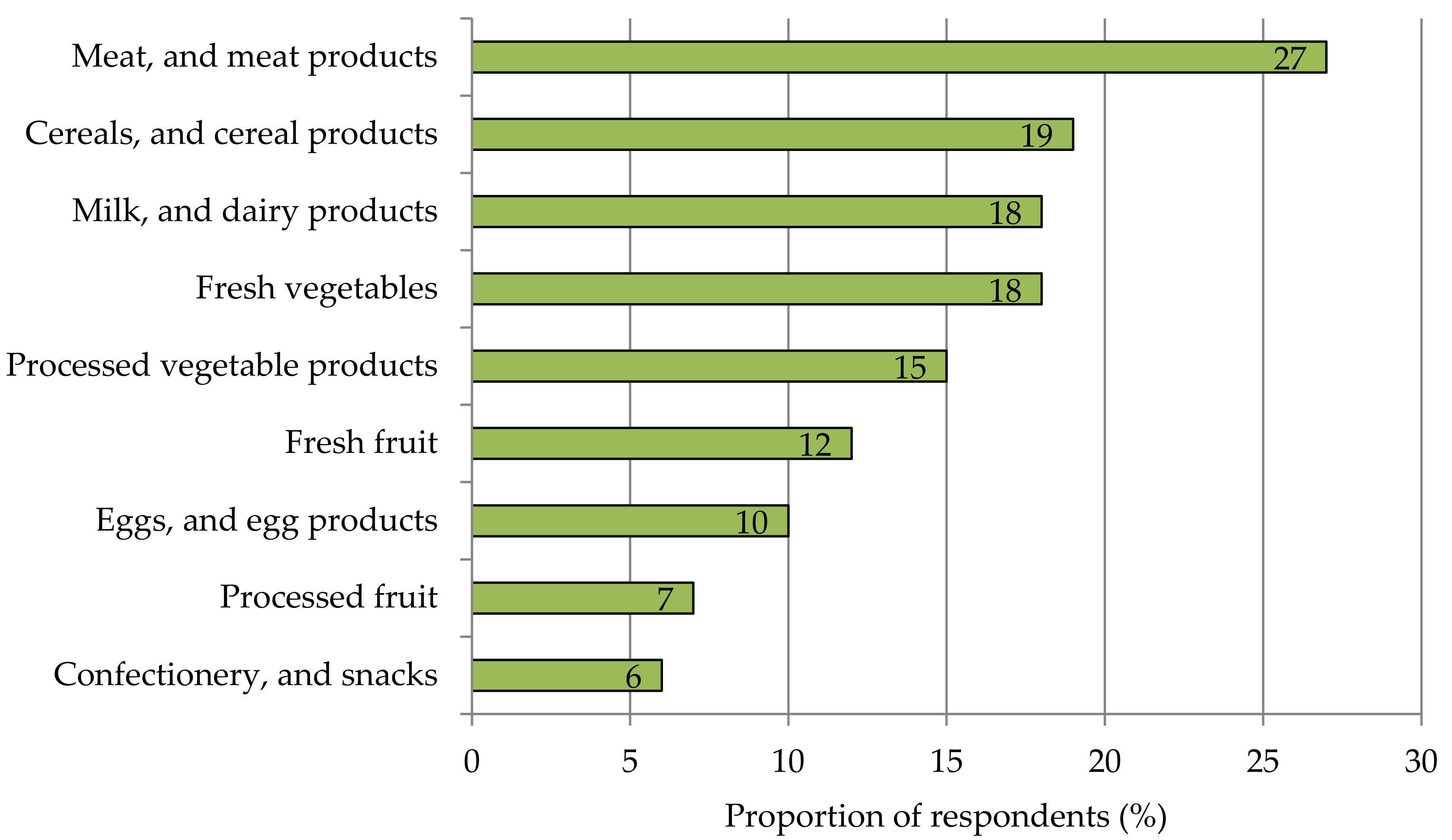

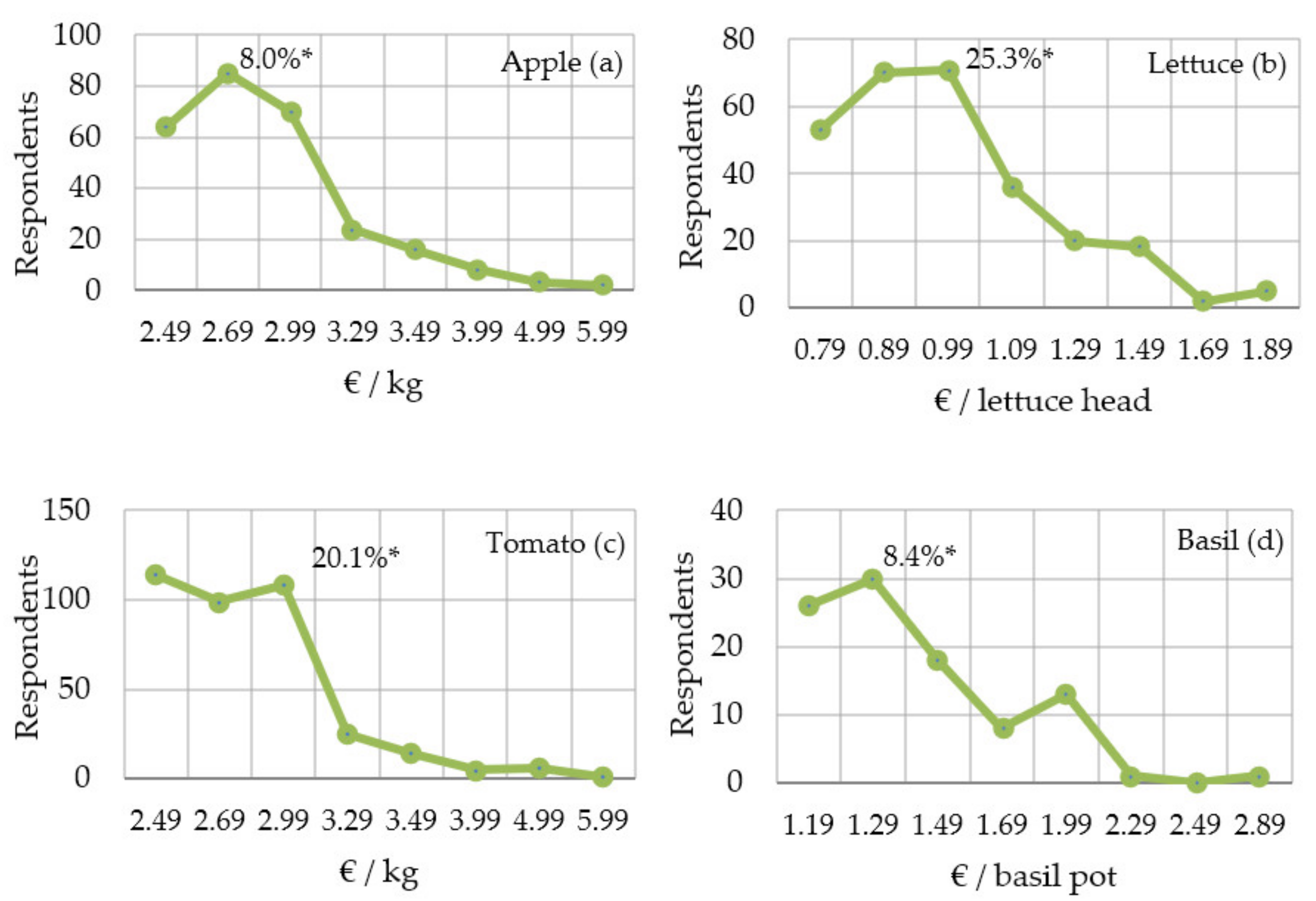
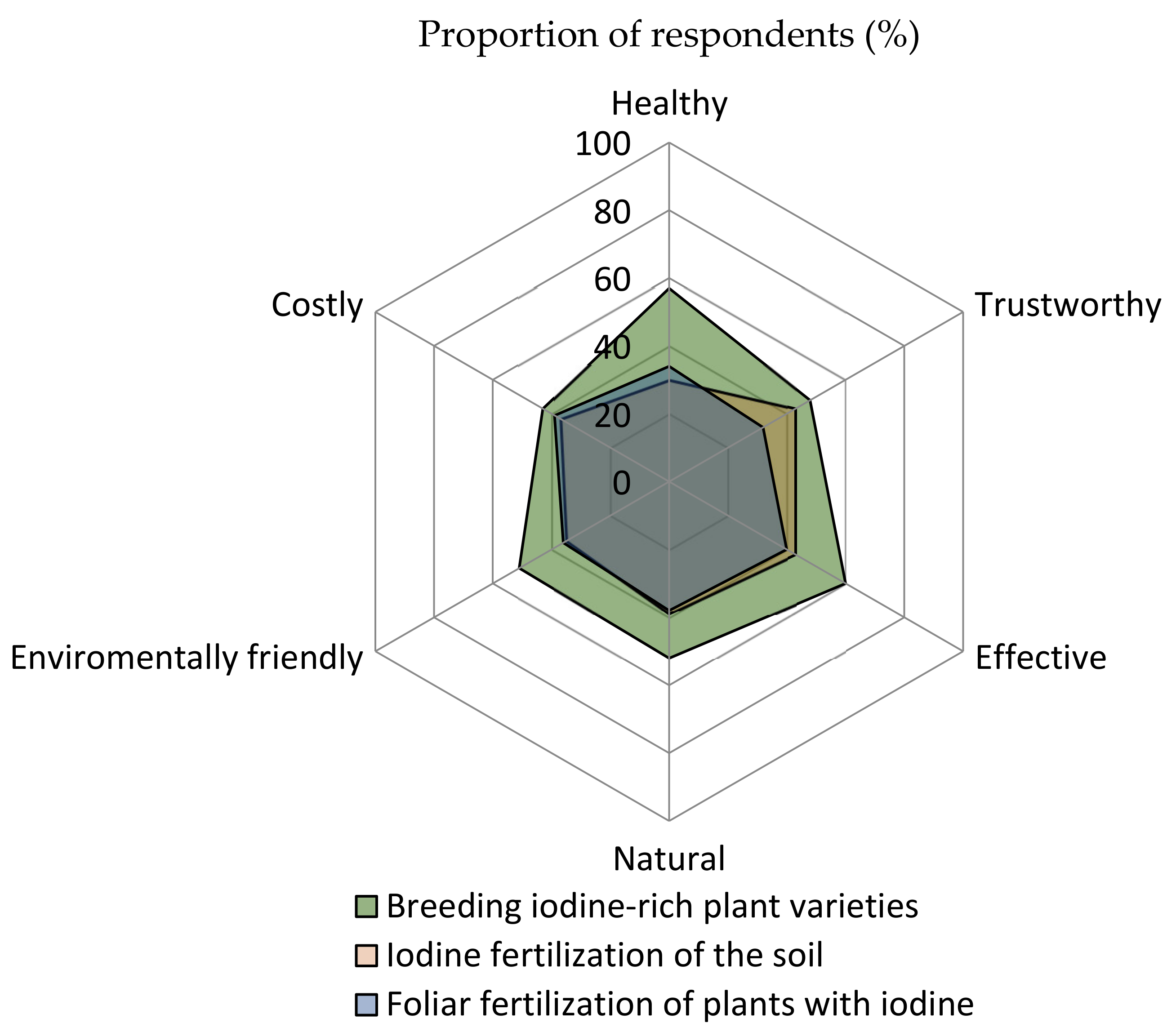
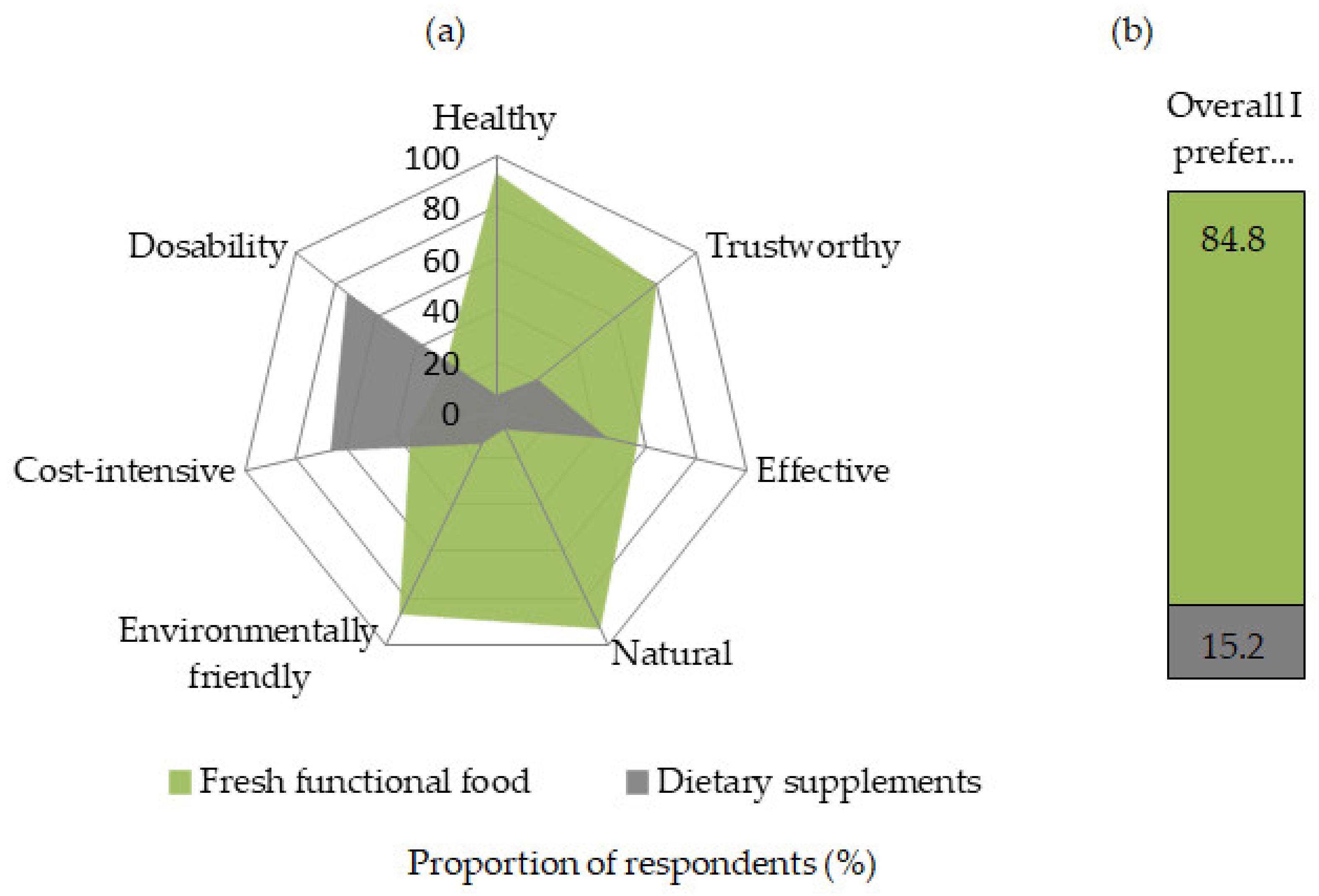
| Characteristics | Sample (in %) | |
|---|---|---|
| Consumption of fresh fruit, and vegetables | Consume at least rarely | 100 |
| Gender | Male | 50 |
| Female | 50 | |
| 18–24 | 10 | |
| 25–34 | 18 | |
| Age | 35–44 | 17 |
| 45–54 | 23 | |
| >55 | 32 | |
| Region in Germany | North | 18 |
| West | 36 | |
| South | 28 | |
| East | 18 | |
| Responsible for purchasing | Mainly myself | 64 |
| Myself and another person | 36 |
| Product | With Information Text (Mean Value) | Without Information Text (Mean Value) | Test of Difference 1 |
|---|---|---|---|
| Apple | 0.76 | 0.60 | F(1.1014) = 3.939, p = 0.047 * |
| Tomato | 0.86 | 0.62 | F(1.1014) = 8.463, p = 0.004 ** |
| Lettuce | 0.73 | 0.62 | F(1.1014) = 2.044, p = 0.153 |
| Basil | 0.42 | 0.37 | F(1.1014) = 0.465, p = 0.495 |
| Iodine-Biofortified Food R2 = 0.395 | Supplements Nagelkerke R2 = 0.210 | |
|---|---|---|
| Sociodemographic variable | ||
| Female Gender | −0.033 (−1.296) | 0.406 ** (9.790) |
| Shopping location | ||
| Farmers’ market, organic produce shop, or farm store | 0.056 * (2.226) | −0.254 (1.499) |
| Attention to labelling | ||
| Attention to functional food labelling when buying food | 0.048 (1.769) | 0.377 ** (22.388) |
| Personal iodine sources (currently) | ||
| Fish as a source of iodine | 0.052 * (2.018) | 0.086 (0.427) |
| Dietary supplements as a source of iodine | 0.043 (1.683) | 1.946 ** (35.787) |
| Labelling iodine content | ||
| High iodine content | 0.146 ** (4.026) | 0.011 (0.020) |
| Enriched with iodine | 0.134 ** (4.317) | 0.075 (1.335) |
| Iodine-biofortified | 0.118 ** (4.003) | 0.184 ** (9.317) |
| Rich in iodine | 0.272 ** (7.891) | 0.021 (0.069) |
| Purchase motives | ||
| Integrated cultivation | 0.097 ** (3.553) | 0.028 (0.192) |
| Produced in Germany | 0.087 ** (3.190) | −0.069 (0.713) |
| Focus on food ingredients | −0.054 (−1.933) | 0.187 ** (8.353) |
| Never buying products with specific health effects | −0.039 (−1.532) | −0.151 * (6.039) |
| Often buying ready-made dishes | −0.031 (−1.191) | 0.218 ** (13.531) |
| Product | Customers of Farmers’ Markets, Organic Produce Shops, and Farm Stores | Discount Consumers | Supermarket Consumers |
|---|---|---|---|
| Apple | 41.8% | 32.6% | 29.7% |
| Tomato | 41.8% | 36.8% | 34.7% |
| Lettuce | 42.9% | 27.7% | 28.2% |
| Basil | 26.8% | 19.0% | 19.8% |
Publisher’s Note: MDPI stays neutral with regard to jurisdictional claims in published maps and institutional affiliations. |
© 2021 by the authors. Licensee MDPI, Basel, Switzerland. This article is an open access article distributed under the terms and conditions of the Creative Commons Attribution (CC BY) license (https://creativecommons.org/licenses/by/4.0/).
Share and Cite
Welk, A.-K.; Kleine-Kalmer, R.; Daum, D.; Enneking, U. Consumer Acceptance and Market Potential of Iodine-Biofortified Fruit and Vegetables in Germany. Nutrients 2021, 13, 4198. https://doi.org/10.3390/nu13124198
Welk A-K, Kleine-Kalmer R, Daum D, Enneking U. Consumer Acceptance and Market Potential of Iodine-Biofortified Fruit and Vegetables in Germany. Nutrients. 2021; 13(12):4198. https://doi.org/10.3390/nu13124198
Chicago/Turabian StyleWelk, Ann-Kristin, Ruth Kleine-Kalmer, Diemo Daum, and Ulrich Enneking. 2021. "Consumer Acceptance and Market Potential of Iodine-Biofortified Fruit and Vegetables in Germany" Nutrients 13, no. 12: 4198. https://doi.org/10.3390/nu13124198
APA StyleWelk, A.-K., Kleine-Kalmer, R., Daum, D., & Enneking, U. (2021). Consumer Acceptance and Market Potential of Iodine-Biofortified Fruit and Vegetables in Germany. Nutrients, 13(12), 4198. https://doi.org/10.3390/nu13124198







